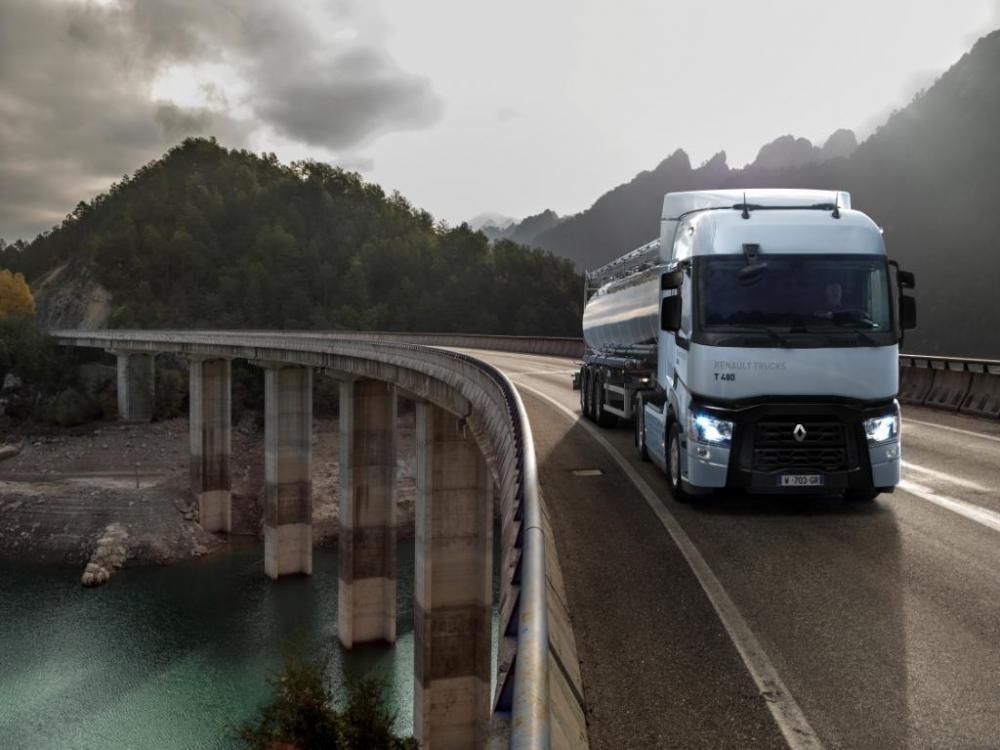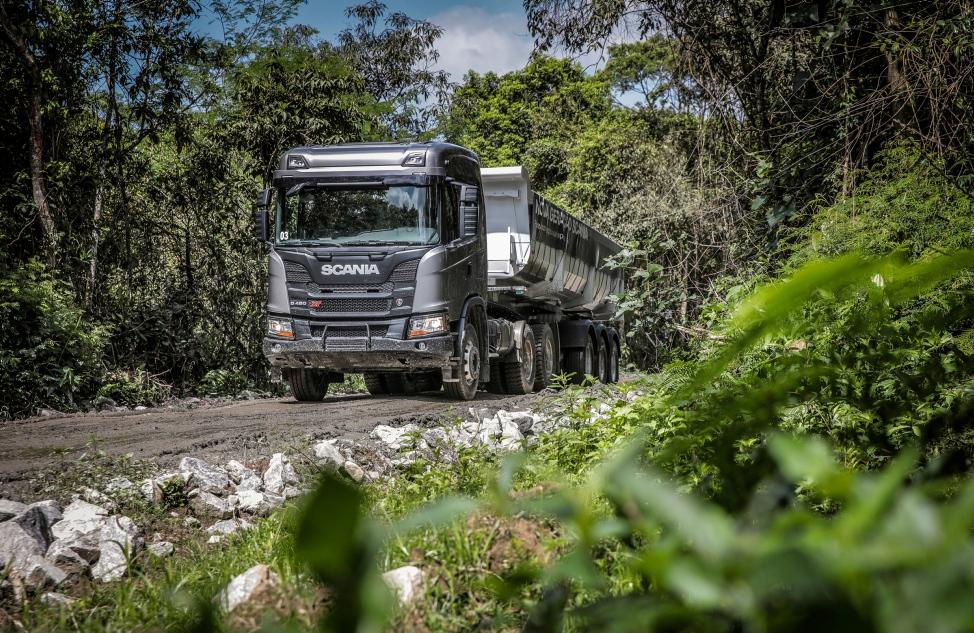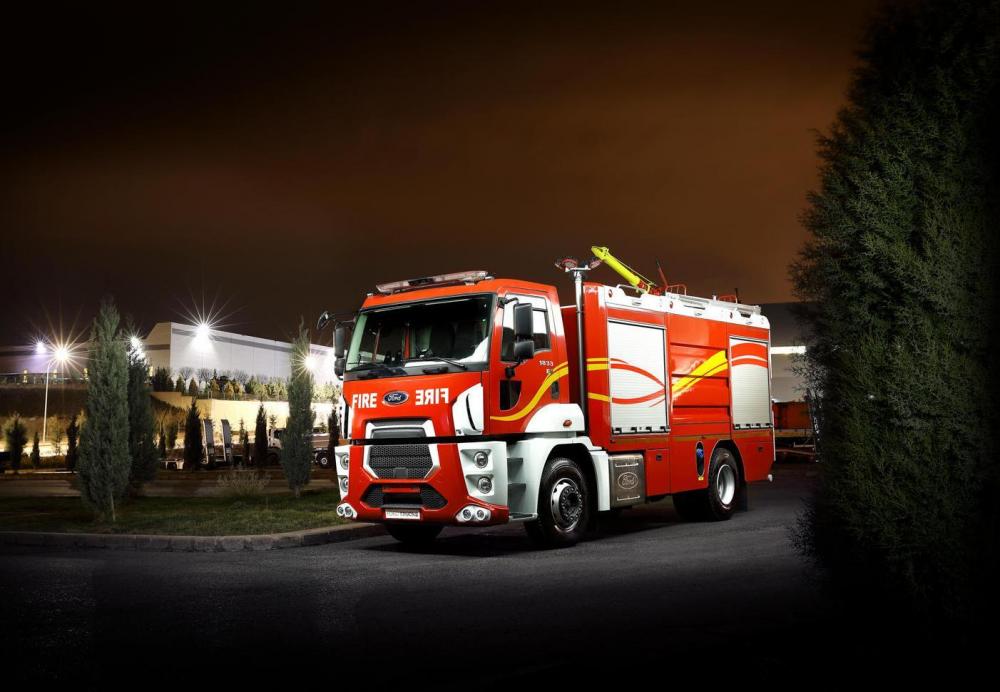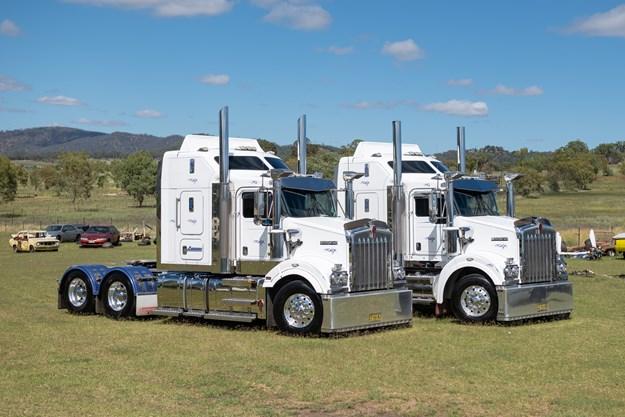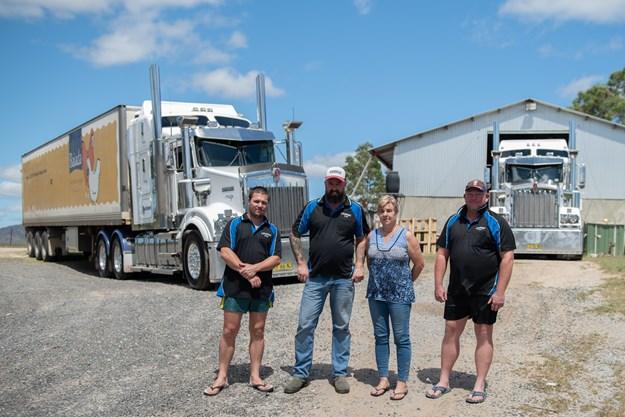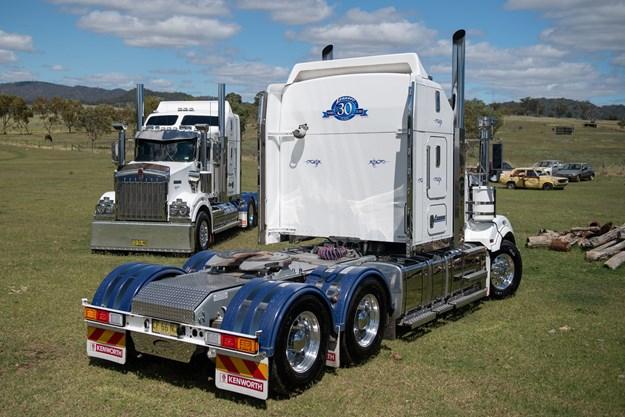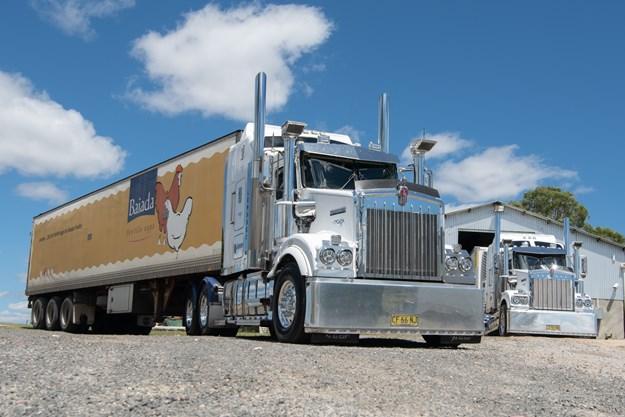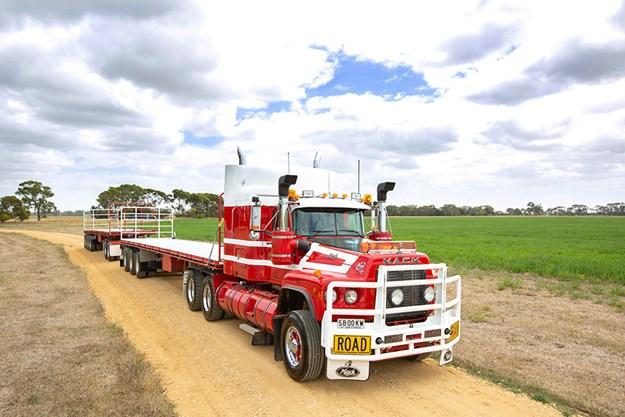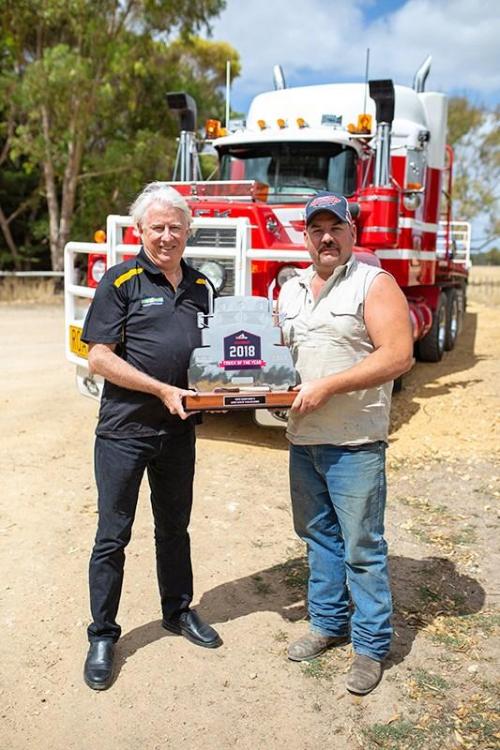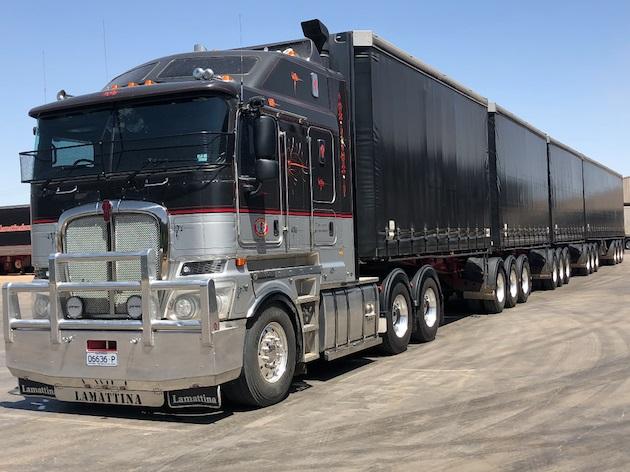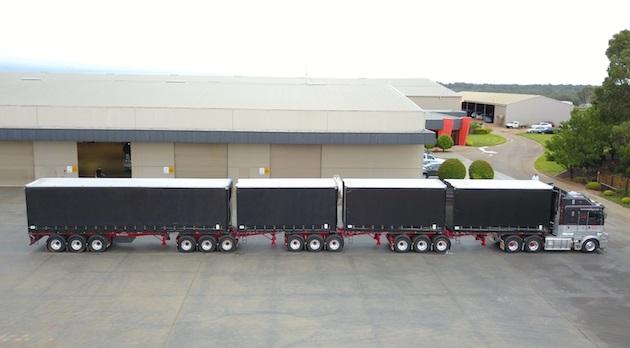
kscarbel2
Moderator-
Posts
18,883 -
Joined
-
Days Won
114
Content Type
Profiles
Forums
Gallery
Events
Blogs
BMT Wiki
Collections
Store
Everything posted by kscarbel2
-
What is Mack thinking?
kscarbel2 replied to hicrop10's topic in Modern Mack Truck General Discussion
. For many, Volvo has that video blocked from being played in the US ("This video is not available in your country"). Here is a workable link. . -
What is Mack thinking?
kscarbel2 replied to hicrop10's topic in Modern Mack Truck General Discussion
1. Too slow/late.....irreversible in-depth damage already done. 2. The North American Titan show was an amateur effort. 3. Why did Volvo abandon the Mack heavy haul segment in the first place? From the day they took over, they ignored the Super-Liner product. -
How a 50-year-old design came back to haunt Boeing with its troubled 737 Max jet Ralph Vartabedian, The Los Angeles Times / March 15, 2019 A set of stairs may have never caused so much trouble in an aircraft. First introduced in West Germany as a short-hop commuter jet in the early Cold War, the Boeing 737-100 had folding metal stairs attached to the fuselage that passengers climbed to board before airports had jetways. Ground crews hand-lifted heavy luggage into the cargo holds in those days, long before motorized belt loaders were widely available. That low-to-the-ground design was a plus in 1968, but it has proved to be a constraint that engineers modernizing the 737 have had to work around ever since. The compromises required to push forward a more fuel-efficient version of the plane — with larger engines and altered aerodynamics — led to the complex flight control software system that is now under investigation in two fatal crashes over the last five months. Boeing’s problems deepened Thursday, when the company announced it was stopping delivery of the aircraft after the Federal Aviation Administration’s decision Wednesday to ground the aircraft. “We continue to build 737 Max airplanes, while assessing how the situation, including potential capacity constraints, will impact our production system,” Boeing said in a statement. The crisis comes after 50 years of remarkable success in making the 737 a profitable workhorse. Today, the aerospace giant has a massive backlog of more than 4,700 orders for the jetliner and its sales account for nearly a third of Boeing’s profit. But the decision to continue modernizing the jet, rather than starting at some point with a clean design, resulted in engineering challenges that created unforeseen risks. “Boeing has to sit down and ask itself how long they can keep updating this airplane," said Douglas Moss, an instructor at USC's Viterbi Aviation Safety and Security Program, a former United Airlines captain, an attorney and a former Air Force test pilot. "We are getting to the point where legacy features are such a drag on the airplane that we have to go to a clean-sheet airplane." Few, if any, complex products designed in the 1960s are still manufactured today. The IBM 360 mainframe computer was put out to pasture decades ago. The Apollo spacecraft is revered history. The Buick Electra 225 is long gone. And Western Electric dial telephones are seen only in classic movies. Today’s 737 is a substantially different system from the original. Boeing strengthened its wings, developed new assembly technologies and put in modern cockpit electronics. The changes allowed the 737 to outlive both the Boeing 757 and 767, which were developed decades later and then retired. Over the years, the FAA has implemented new and tougher design requirements, but a derivative gets many of the designs grandfathered in, Moss said. “It is cheaper and easier to do a derivative than a new aircraft,” said Robert Ditchey, an engineer, aviation safety consultant and founder of America West Airlines, which purchased some of the early 737 models. “It is easier to certificate it.” But some aspects of the legacy 737 design are vintage headaches, such as the ground clearance designed to allow a staircase that’s now obsolete. “They wanted it close to the ground for boarding,” Ditchey said. Andrew Skow, founder of Tiger Century Aircraft, which develops cockpit safety systems, and a former Northrop Grumman chief engineer, said Boeing has had a good record modernizing the 737. But he said, “They may have pushed it too far.” To handle a longer fuselage and more passengers, Boeing added larger, more powerful engines, but that required it to reposition them to maintain ground clearance. As a result, the 737 can pitch up under certain circumstances. Software, known as the Maneuvering Characteristics Augmentation System, was added to counteract that tendency. It was that software that is believed to have been involved in a Lion Air crash in Indonesia in October. The software erroneously thought the aircraft was at risk of losing lift and stalling — because of a malfunctioning sensor — and ordered the stabilizer at the rear to put it into a series of sharp dives that ultimately caused the plane to crash into the Java Sea. What happened on the Ethiopian Airlines flight is less clear, but tracking data show that it also encountered sharp changes in its vertical velocity and at one point in its climb after takeoff lost 400 feet of altitude. The FAA grounded the jetliner Wednesday, saying that new satellite data showed the Ethiopian Airlines flight dynamics were “very close” to those of the Lion Air jet. Ethiopia sent “black box” recording devices recovered from the crashed jet to France for analysis, after refusing to hand them over to U.S. authorities. The U.S. National Transportation Safety Board still plans to send investigators to France to help its Bureau of Inquiry and Analysis for Civil Aviation Safety. Airline crashes seldom are caused by a single factor, and the two 737 accidents may yet involve poor maintenance, pilot errors and inadequate training. But it appears increasingly likely that Boeing’s software system and the company’s lack of recommendations for pilot training on it may have played an important role in the crashes. The entire need for the software system is fundamental to the jet’s history. The bottom of the 737’s engines are a minimum of 17 inches above the runway. By comparison, the Boeing 757 has a minimum clearance of 29 inches, according to Boeing specification books. The newer 787 Dreamliner has 28 inches or 29 inches, depending on the engine. The 737 originally was equipped with the Pratt & Whitney JT-8 series jets, which had an inner fan diameter of 49.2 inches. “They looked like cigars, long and skinny,” Moss said. By comparison, the LEAP-1b engines on the Max 8 have a diameter of 69 inches, nearly 20 inches more than the original. There wouldn’t be enough clearance without some kind of modification. In the 737-300, which came after the original planes sold in West Germany, Boeing came up with an unusual fix: It created a flat bottom on the nacelle (the shroud around the fan), creating what pilots came to call the "hamster pouch.” “They made it work,” said Ditchey, whose America West was one of the original customers of the 737-300. But the LEAP engines required an even bigger change. Boeing redesigned the pylons, the structure that holds the engine to the wing, extending them farther forward and higher up. It gave the needed 17 inches of clearance. The company also put in a higher nose landing gear. The change, however, affected the plane’s aerodynamics. Boeing discovered the new position of the engines increased the lift of the aircraft, creating a tendency for the nose to pitch up. The solution was MCAS, which ordered the stabilizer to push down the nose if the “angle of attack” — or angle that air flows over the wings — got too high. The MCAS depends on data from two sensors. But on the Lion Air flight, the MCAS relied on a sensor that was erroneously reporting a high angle of attack when the plane was nowhere near a stall. The pilots tried to counteract the nose-down movements by pulling back on the yoke. But even pulling with all their might they could not counteract the forces, according to data in a preliminary accident investigation report. Skow criticized Boeing’s MCAS system, saying it acted only on the basis of angle of attack. The Lion Air jet was traveling so fast that when MCAS ordered the stabilizer to pitch the nose down it was a violent reaction. The software should have factored in air speed, he said, which would have better calibrated the pilots’ reaction. Skow’s firm has developed a cockpit display system, known as Q-Alfa, which he says would have identified the failure of the angle of attack sensor and allowed the crew to abort the takeoff. “We believe we could have prevented the accident,” he said. If the results of the investigation do not undermine the fundamental design of the aircraft, then the 737 Max’s future may not be in peril, aviation experts said. It may turn out all that’s needed is a software fix or additional pilot training. The 737 has survived other crises. In a 1988 accident on a flight between Honolulu and Hilo, the entire top of the plane came off in an explosive decompression. A flight attendant was sucked out and 65 passengers and crew were injured. It was blamed on faulty lap joints in the aluminum skin of the fuselage, which Boeing re-engineered.
-
Daimler Press Release / March 13, 2019 The Sideguard Assist has been available since 2016 in the Mercedes-Benz Actros and minimises the probability of dangerous accidents on the co-driver's side when the vehicle turns to the right. It has now been revised and improved for the digital future of trucks. In the new Actros, Sideguard Assist uses the MirrorCam display to warn drivers visually when the system detects a moving or stationary object in the monitored zone on the co-driver's side of the truck. The system can thus warn drivers in good time on the monitor of cyclists or pedestrians they may not have seen. MirrorCam and Sideguard Assist work hand-in-hand – overloading the driver with information is thus avoided and all of the relevant warnings are located together in a single location. In line with the launch of the new Actros, Sideguard Assist can now additionally support the driver under certain conditions when turning to the left. .
-
Renault Trucks Press Release / March 15, 2019 Renault Trucks has ended 2018 with a total volume of 54,868 vehicles invoiced, up 10% on the previous year. In a buoyant European market, the French manufacturer has strengthened its positions and increased over 16-ton market share by 0.2 points. In 2018, Renault Trucks recorded its fourth consecutive year of sales growth. The manufacturer has announced a rise of 7.6% in MHDV, and 15% in LCV. Breakdown in invoicing per destination - Europe (excluding France): 26,830 units invoiced (+13.5%) - France: 23,581 units invoiced (+10.1%) - Rest of the world: 4,457 units invoiced (-8.8%) Significant growth in volume in Europe In a dynamic European market for vehicles over 6 tons (up 4.2%), deliveries of Renault Trucks vehicles are up 7.6%. This has led to a slight increase in the French manufacturer’s market share, up 0.1 point to 8.5%. In the over 16-ton segment, Renault Trucks’ market share in Europe is up 0.2 points, at 8.9%. For vehicles between 6 and 16 tons, market share is down 0.3 points (6.2%). Registrations are down 3.8% due to the stoppage of the Renault Trucks D cab 2m model. On a like-for-like basis however, penetration remains identical. Renault Trucks has strengthened its position as leader in its home market, with a 28.1% market share. International sales marked by an upturn in Africa Deliveries of Renault Trucks vehicles have fallen 8.8% internationally, with 4,457 trucks invoiced. This downturn can be explained by the introduction of import quotas in Algeria in 2018. The manufacturer is particularly active in Africa, where sales have grown 25% in 2018. In French-speaking Africa, Renault Trucks holds 20% of the premium range market (+1 point). In 2018, the constructor also recorded good performance in Turkey (+2.1 points with 5.8% of MS) and in the Middle East (+1.1 point with 6.4% MS). A record 23% increase of for Renault Trucks used trucks In 2018, Renault Trucks recorded a record increase in sales of used trucks, with 8,500 invoiced vehicles, up 23%. Used trucks service offers are also performing well, notably due to the Selection structure warranty, with a penetration rate of 18%, up 6 points. Used vehicles represent a strategic sector for Renault Trucks. In 2017, the manufacturer opened a “Used Trucks Factory” at its Bourg-en-Bresse plant to recondition its used vehicles. In 2018, 400 used trucks were reconditioned there to meet customer requirements (compared to 230 in 2017). The aim is for vehicles from the Used Trucks Factory to eventually represent 10% of total sales of used vehicles. After the T X-Road, Renault Trucks launched another model from its Used Trucks Factory in 2018, the T P-Road, a tractor converted into a rigid truck. After-sales: spare parts turnover up 5% Renault Trucks after-sales division has reported steady progress of 5% in its spare parts turnover and a healthy increase in the sales of its maintenance contracts. With 32,000 vehicles under contract, the penetration rate of maintenance contracts grew by 5 points in 2018 to reach 23.6% (29% if Clovis Location contracts are included). 60,000 vehicles now benefit from a Renault Trucks maintenance contract or extended warranty. It is of note that Renault Trucks offers transporters ideal protection for operating with complete peace of mind, since the constructor has extended its guarantee warranty on spare parts fitted by an approved Renault Trucks service centre to 2 years, without any mileage restrictions. Renault Trucks preparing for the future Fuel savings and reducing CO2 emissions have always been a core concern for Renault Trucks. The manufacturer is therefore investing fully in complying with the limits set by the EU as regards CO2 emissions. At the end of 2018, Renault Trucks announced the launch of the 2019 versions of the T, D and D Wide models, designed to reduce fuel consumption by up to 7% compared to previous versions. Renault Trucks is also continuing its research into improving the efficiency of diesel vehicles, with its Optifuel Lab 3 laboratory vehicle. The aim is to reduce fuel consumption by 13% for a full heavy vehicle unit by 2020. Last but not least, for an immediate improvement in air quality, Renault Trucks will be launching its D and D Wide Z.E electric trucks in 2019, manufactured in its Blainville-sur-Orne factory. The Renault Master Z.E., on the other hand, is already being distributed in the Renault Trucks network. .
-
Robin Rasper, Goteborgs-Posten / March 12, 2019 A strong increase in sales with good profitability - AB Volvo is now approaching SEK 400 billion in sales. And the fourth quarter also provided increased earnings and improved margins. The improved deal is now also visible in the Volvo CEO's wallet. Last year, Martin Lundstedt raised his basic salary to SEK 14.6 million, from SEK 13.1 million a year earlier, shows the company's annual report for 2018. The CEO also discards a short-term variable remuneration of SEK 12.5 million. That is 87.7 percent of the bonus-based salary. According to the long-term variable incentive program, he will also receive SEK 10 million, which will be reinvested in Volvo B shares, if the upcoming general meeting gives a thumbs up. In addition to basic salary and bonus programs, the truck manager also has other advantages, mainly in the form of car and housing benefits. These amounted to just over SEK 300,000 in 2018. All in all, AB Volvo's CEO received a remuneration of just over SEK 37 million last year, including the remuneration from the long-term bonus program. Martin Lundstedt is also covered by a number of pension plans, in addition to the collective agreement pension benefit. In total, the Volvo Manager's pension premiums amounted to SEK 6.1 million in 2018, according to the recent annual report. AB Volvo reported an adjusted operating profit of just under SEK 40.7 billion for the full year 2018. This meant that the margin increased from 8.8 to 10.4 percent. .
-
You're welcome. The BMT family aims to please.
-
Scania Group Press Release / March 14, 2019 2018 was a year of continued growth and of records in many areas, while we carried out the biggest industrial transition in the company’s history. Summary of the full year 2018 Operating income amounted to SEK 13,832 m. (12,434) Net sales increased by 11 percent to SEK 137,126 m. (123,366) Cash flow amounted to SEK 3,665 m. (5,696) in Vehicles and Services As from the 2018 financial year, the presentation of the income statement has been adjusted to align with Volkswagen Group’s (including comparative periods) Comments by Henrik Henriksson, President and CEO “2018 was a year of continued growth and of records in many areas, while we carried out the biggest industrial transition in the company’s history. Deliveries of trucks, buses and coaches, as well as engines reached all-time high levels, and so did service volume. Scania’s net sales amounted to SEK 137.1 billion, an increase of 11 percent compared to the previous year. Earnings rose to SEK 13,832 m., which gave an operating margin of 10.1 percent. Higher vehicle and service volume contributed positively and so did currency effects while higher production costs for running double product ranges and disruptions in the supply chain impacted earnings negatively. With the changeover of production in Latin America during the first quarter of 2019, we will have completed the global transition to Scania’s new truck generation. This final stage of the changeover will lead to some limitations in the flexibility and capacity of our global production system. There is still a higher than normal cost situation in general for products and production related to the new truck generation. Measures to normalise cost levels have been introduced. With continued high capacity utilisation of our customers’ installed truck fleets and Scania’s continually improving service offering, which is built on data from more than 360,000 connected vehicles, our service business is continuing to grow. Service revenue increased by 12 percent in 2018 to a record high SEK 26.6 billion. Financial Services reported operating income at the all-time high level of SEK 1,440 million. Order bookings for trucks fell by 12 percent in 2018 compared to the high level during the year-earlier period. Demand in Europe remains at a good level, with a high level of customer activity. In Latin America, Brazil’s recovery is progressing. In Asia, order bookings fell in 2018 compared to last year, due to Middle East. Demand in Eurasia remains strong, even though order bookings decreased somewhat in Russia towards year-end. Buses and coaches is also negatively affected by a lower order intake in Middle East but overall order bookings is in line with last year. In the Engines business area, demand is strong in all segments. In 2018 order bookings were positively affected by a pre-buy effect in Europe.” .
-
Feds move to consider cars with no steering wheels, brakes
kscarbel2 replied to kscarbel2's topic in Odds and Ends
Umm........who decided that the future that involves cars without steering wheels and brake pedals on public roads ??? I must have missed that memo. -
Feds move to consider cars with no steering wheels, brakes
kscarbel2 posted a topic in Odds and Ends
Pete Bigelow, Automotive News / March 15, 2019 Three days after U.S. Department of Transportation Secretary Elaine Chao said her department would become "more innovation friendly," the department took the first steps toward a future that involves cars without steering wheels and brake pedals on public roads. The Transportation Department on Friday issued a request for comment on a petition from General Motors seeking an exemption from Federal Motor Vehicle Safety Standards that assume a human drives a car and requires traditional controls. GM asked for an exemption in January 2018. For 15 months, the company and others developing self-driving systems have awaited a response as they embark on plans to design and manufacture fully automated vehicles. GM's petition has been viewed as a litmus test on the Transportation Department's willingness to pave the way toward a self-driving future. The public has 60 days to comment on the request, and then the Transportation Department will begin formulating a ruling on the petition. "The department is actively seeking public comment on proposed exemptions to federal standards and how the public can be protected as new transportation technologies emerge," Chao said. Manufacturers can submit petitions to NHTSA, the nation's top auto safety regulator, to apply for exemptions from federal standards that were developed, in many cases, decades before automated-driving technology was a glint in the eye of engineers. There's a cap of 2,500 vehicle exemptions per manufacturer, according to the Transportation Department. GM and its Cruise subsidiary were not the only ones seeking an exemption. Nuro, an upstart that said last month it had received $940 million in funding from SoftBank's Vision Fund, has filed a petition for an exemption from safety standards that mandate rearview mirrors, a windshield and a backup camera. Nuro plans to offer delivery services, not transportation for humans, so the company argues those features are unnecessary. The company is testing prototype vehicles in Arizona and Houston. This week during an appearance at the SXSW arts and technology festival in Austin, Texas, Chao said the Transportation Department needed to welcome transportation innovations. "The department will remain technology neutral, but be a lot more innovation friendly and will help safe and better transportation options become available more quickly," she said. Along those lines, Chao announced the creation of the Non-Traditional and Emerging Transportation Technology Council, a body of high-ranking Transportation Department officials that will help accelerate decisions, especially in instances when new technologies -- such as automation and hyperloop, for two examples -- cut across traditional modes of transportation. The request for comment may not have emerged from the new council, but taken together, the two developments this week show the Transportation Department taking actions that support its innovation-friendly posture. For its part, GM welcomed Friday's request for comment. "General Motors is pleased that NHTSA will post the petition for public comment," a company spokesman said. "We look forward to continuing to work with NHTSA and other stakeholders as we move through the petition process." -
https://www.bigmacktrucks.com/topic/42121-mack-frames-1997/ https://www.bigmacktrucks.com/topic/42109-mack-frames-1989/
-
What is Mack thinking?
kscarbel2 replied to hicrop10's topic in Modern Mack Truck General Discussion
You need to rephrase your question to “what is Volvo Group thinking”. -
Your problems with Virginia Paul pale in comparison to the money state taxpayers will be giving Amazon to locate there. Virginia has crashed since Her Majesty lost control of this colony. -------------------------------------------------------------------------------------------------------------------------------------------- A five-member panel of the Arlington County Board will vote on whether Amazon will receive the estimated $51 million, a fraction of the $481 million promised by the county. Five percent of the incentives are direct. Amazon has also been offered a $750 million package by the state that the Virginia General Assembly approved with little opposition. https://www.reuters.com/article/us-amazon-com-headquarters-vote/amazons-second-headquarters-faces-new-blocks-in-virginia-funding-vote-idUSKCN1QX08V
-
Ford Trucks International / March 15, 2019 Whether you’re a one-unit fire department in a small town or operating 500 trucks in a large city, you are expected to demand maximum value for each tax dollar. That’s where Ford Trucks can help. Ford has a broad line-up of truck chassis specially engineered for fire and rescue. Why buy Ford? At Ford Trucks, we are committed to providing you with the latest technology in the truck industry, trucks that are “optimized” by our engineers to meet your specific requirements. That’s why we say, “Ford Trucks are built Ford tough”. .
-
Granite vs T800 and T880
kscarbel2 replied to james j neiweem's topic in Modern Mack Truck General Discussion
No they can't, Mark. -
Granite vs T800 and T880
kscarbel2 replied to james j neiweem's topic in Modern Mack Truck General Discussion
The Volvo and Mack customer quotes, spec'd similarly to the competition, on average are $10,000 higher. -
Owner-Driver / March 15, 2019 A couple of blinged-up Kenworth SARs have proved the sparkling final touch to Tamworth-based Lenssec Transport’s ‘eggspress’ deliveries Everybody knows the old saying, ‘Don’t put all your eggs in one basket’. It also appears to be very sound advice. However, before this adage became ingrained in our society, a very rich man by the name of Andrew Carnegie was quoted as saying, "Concentrate your energies, your thoughts and your capital. The wise man puts all his eggs in one basket and watches the basket." What he was saying also makes perfect sense – specialise in one area and focus on doing it well. Lenssec Transport in Tamworth has been doing that for over 30 years, and the funny part is their success has relied almost entirely on eggs. The operation literally has put all its eggs in one basket. Sure, Lenssec Transport has had its share of ups and downs. They’ve even tried a few different types of ‘baskets’ but now, 33 years after Cessil Turner (one half of Lenssecs’ original founders) started working as a delivery driver for Baiada, the team is still going strong. The ‘baskets’ they use today are two of the most stunning Kenworth SARs you will find. Now I have to be very careful writing this story as I have never covered a company that deals with such fragile freight and there is the temptation to get overly ‘egg-cited’ with puns. I’m definitely no ‘eggs-pert’ journalist so I need to be careful and watch out that I don’t overcook it. The last thing I want is to poach any ‘egg-celent’ puns off the internet just for a cheap laugh. I think I have that out of my system now, so we can move on and ‘eggs-plain’ the story behind Lenssec’s success (that was the last one, I promise). Chances are if you have travelled the southern end of the New England Highway between Tamworth and Sydney you would have seen one or both of the Lenssec Kenworth T409SARs. For truck lovers of any brand these two trucks are spot on. With just the right level of exterior extras and with dedicated drivers that keep them looking immaculate, these trucks are head turners. Coincidentally Turner is the family name behind the Lenssec badge. In 1986 Cessil Turner started working for Baiada in the company’s V8 Dodge. He would run as far as Marsden Park in Sydney with loads of fertile eggs. As the business grew, so did the loads and it didn’t take long before management approached Cessil about buying his own truck and taking on more work. Cessil and his wife Eleni jumped at the opportunity and formed Lenssec Transport. (‘Len comes from Eleni and ‘Ssec’ is the reverse of Cessil’s name.) Asleep on the wheel The first truck in the fleet was a single drive day cab UD with a bogie-axle 32ft trailer. Though it was a step up from the Dodge, it was still old school trucking in those days. "He’d leave at midnight and if he got a bit doughy he’d have a sleep over the steering wheel," Eleni recalls. Eleni’s son Craig, who now runs the show alongside his mum, also recalls his dad saying, "No point getting too comfortable, you’d sleep for too long!" Craig laughs as he also remembers his dad explaining the alarm clock he used back in the day. "You just put your arms down and when your hands go to sleep you’d wake up." Definitely an old school alarm clock. Eleni and Cessil’s solid bond with Baiada was established in those formative years. The old UD with a spring trailer carting fertile eggs down the infamous Putty Road to Sydney was no easy feat. Personally, I know I have enough trouble getting them home from the supermarket without breakages. The service they provided established their reputation and was the basis for their decade long relationship with one of Australia’s largest egg manufacturers. The day cab UD was eventually replaced with a sleeper cab version. For most of us, the sleeper cab UDs in those days meant somewhere to put your lunchbox, but for Cessil it was a massive improvement. As Baiada grew, so did the workload for Lenssec. With an increased workload meant the need for a bigger truck. The UD was replaced with their first brand new unit, a 1994 Kenworth T400. "It was a pretty looking truck, but it wasn’t much of a truck," Craig admits, quickly adding, "It was a bit of a lemon for us." The T400 was the start of Lenssec’s growth though. In 1995 they bought their first new trailer and in 1996 the T400 was traded in for what would become the workhorse of the fleet – a 1996 International S-Line. Eleni adores the S-Line. "They are great trucks!" she says. "If they bought out S-lines again they wouldn’t be able to keep up with sales." "The S-line was our saviour, it’s done so many miles for us," Craig points out. While more trucks would come and go from the fleet, the S-line, with nearly three million kilometres under the belt, is still part of the fleet. Craig also says there’s no shortage of offers from many people to take it off their hands. A resounding "no" is the common answer. With the workload increasing it was time for Lenssec to become a multi-truck fleet. An Iveco MP4700 was ordered and added. For almost a decade these two trucks kept Lenssec going, fulfilling the growing egg market and racking up millions of kilometres between Sydney and Tamworth. Unfortunately, in 2006 tragedy struck the Lenssec family when Cessil was killed in an unfortunate accident while fuelling up in Singleton. The death of such a legendary character like Cessil hit his family and the community hard and changed the business forever. With such tragedy comes the best of the human spirit. The coming together of family, friends and workmates at difficult times often reflects the impact that people have on those around them. Craig is very quick to exclaim the virtues of all those that dug in to help the family at that time. At the time of Cessil’s passing the company had two fulltime drivers, Cessil and John, who had been with Lenssec for over a decade. Eleni was doing a bit of the company paperwork with Cessil doing most of the general day-to-day running. After the accident Eleni and Cessil’s son Kevin left his job and drove Cessil’s truck in order to keep up with the Baiada workload. Craig, a diesel mechanic by trade, kept his job at a local Tamworth workshop and spent his mornings and nights working for the family business before joining Lenssec fulltime 12 months later. Battling on Eleni is extremely down to earth and openly admits the choice to dig in and keep the company going after the accident. "It had nothing to do with passion," Eleni states. "It had to do with your debt. You would either throw your hands in the air and sell the equipment and still owe money or you had to keep fighting." Working with siblings isn’t always the smoothest ride and Kevin eventually moved on to another project and it was Eleni and Craig that moved Lenssec forward. The Iveco was eventually sold off and replaced with the first of what would be three Western Stars to grace the Lenssec fleet. Starting with a 2008 Constellation 4800, there would be another in 2010 and again in 2014. As 2016 rolled around and Craig was looking to upgrade the older of the Stars, finances and the price of the Aussie dollar meant the idea of a new Kenworth became a distinct possibility. "You know what it’s like," quips Craig with a smile. "Kenworth’s a Kenworth, it’s the pinnacle." Though Kenworth’s can sell themselves, the deciding factor for Craig and Eleni to switch from their trusty Stars came down to salesman Alex Milne at Brown & Hurley Tamworth. "That’s what pushed me into Kenworth; the customer service from Alex was amazing. He’d bend over backwards for you". Craig admits the lure of the big bonnet 90 series was definitely calling he knew they wouldn’t be the right fit for Lenssec’s needs. A flick through the brochures and Craig fell in love with the SAR. "The SAR, it’s got to be that, that old school look" … and so it was. The wow factor of Lenssec’s trucks has slowly and surely crept in thanks to Craig. He began by adding a few extras on the first Western Star, a bit more on the next and even more on the next. When the first SAR was ordered, salesman Alex Milne would have used up all the ink in the first pen ticking all the boxes. Eleni and Craig both laugh as he recalls getting Alex to hide half the bling in the final bill of the 2018 SAR. It’s not just the looks though. Both SARs sport 50ft bunks with all the mod cons inside including stand-up fridges and sleeper air. While the trucks currently only run Tamworth to Sydney, Eleni wants them to be set up for the drivers should they need to be away for a longer period of time. Having the right ‘baskets’ to do the job is only a small part of the puzzle these days, having the right people to steer and look after those ‘baskets’ is a more important piece. "It’s not a job for everyone," Eleni admits, referring to the multi pick-up side of things as well as the hand loading and unloading. Both Eleni and Craig express their appreciation for the drivers they’ve had in the past, and give full credit to the two boys Aaron ‘Jonno’ Johnson and Neil ‘Fitzy’ Fitzsimmons that drive the SARs now. Both guys do an exceptional job looking after the delicate loads through good driving and looking after their stunning rides through meticulous care and attention. So with three decades of service to Baiada under their belt, the Lenssec team just keep getting better. They’ve put all their eggs in a couple of stunning SAR ‘baskets’ and with a close eye kept on them, the shine will continue. It’s ‘eggs-ceptional’ work all round! .
-
- 1
-

-
Owner-Driver / March 11, 2019 Nick Radford laughed surprisingly after he picked up the phone in February when told his 1990 Mack Valueliner had been voted the Owner//Driver Tranzmile Truck of the Year for 2018. This was the inaugural running of the Tranzmile-sponsored award, and the other 11 contenders of various makes and models were of a much more recent vintage. However, Nick was even more impressed when I arrived at his Radford Pastoral property at Penola in South Australia a few days later with the shiny 7kg trophy. "Surprised? Very much actually," Nick said on receiving the trophy. "It’s good that the public liked the truck, the old girl." Voting for the Owner//Driver Tranzmile Truck of the Year took place on the publication’s website at www.ownerdriver.com.au, beginning on December 1, 2018 and closing on January 17 this year. Nick had originally bought the Valueliner to be done up and taken to truck shows. But a surge in work around the farm at Penola brought the old Mack out of semi-retirement. "It became an everyday truck, and it was out on the road with a water tanker and single side tipper," he says. "It’s a little bit gravel-rashed since we’ve done it up, a few stone chips or whatever, but it’s still in good order and condition." As told in the article which appeared in Owner//Driver’s February 2018 edition, Nick has had diesel in his veins from a young age. Especially Mack trucks. "I was 13 when that was built," he says, pointing to the Value-Liner. "Dad had one; that was fond memories for me going with dad and the drivers in those era trucks. "Now there’s a whole new generation of young fellas that weren’t even around when those trucks were made. "Those trucks were dead and gone, and they’re interested in them. "They’re loud, they use heaps of fuel, sound good, look good, so there’s a bit of a following with the old trucks." The Value-Liner’s refurbishment meant swapping the original 12-speed ’box with an 18-speed Roadranger. "The old 12-speeds, not that they’re hard to drive, but they’re a different ’box if you’re not really trained up on them." As well as the Valueliner, Nick has an ’81 Super-Liner stored I the shed, plus four Kenworth working trucks, three of which – a T904 and two T908s – he took to the Koroit Truck Show earlier this year. The Value-Liner, the old Super-Liner plus a Mack Southern Cross which is currently under restoration and his father’s W Model, made the trip to Kyabram for the biennial Mack Muster three years ago. But attending truck shows is time consuming, especially when you have a large property to look after. Nick, however, has the Mack Muster at Gatton in south-east Queensland during September marked tentatively on his calendar. The event will coincide with the celebration of 100 years of Mack trucks in Australia. "That would be really good," he says. "I’d like to get there." Hopefully, if the Mack Valueliner does make the trip, the Owner//Driver Tranzmile Truck of the Year trophy will be hitching a ride in the passenger seat. .
-
VIC transport operation reports breakthrough efficiencies with PBS B-quad combination Prime Mover Magazine / March 15, 2019 After utilising Performance-Based Standards (PBS) to last year gain approval to operate B-quads in Victoria, New South Wales and Queensland, vegetable grower Rocky Lamattina & Sons is reaping the rewards of this ultra-efficient combination. “We obviously went into this expecting a good outcome in terms of enhanced operational efficiencies compared to the B-triples we’d been using, but the B-quad has well and truly exceeded our expectations, making all the hard work to get it over the line well worth it,” said Angello Lamattina, Director of Rocky Lamattina & Sons. “I’d like to acknowledge the efforts of everyone involved with making this happen, including the National Heavy Vehicle Regulator (NHVR), for their vision and foresight in enabling us to get this highly efficient combination up and running.” In describing the situation, Lamattina suggested that while the benefits of a B-triple over a B-double are reasonable, moving to the B-quad has enabled the company to reach a critical mass in that it now has the means to haul virtually the equivalent of two B-double loads with vastly reduced running costs compared to operating two individual B-doubles. “With our haulage work from Victoria to Queensland we couldn’t get enough weight on the B-doubles so we got permits to run B-triples which gave us an extra 15 to 20 tonnes of payload,” said Lamattina. “However, the extra weight meant we had to use a different route which adds 150 kilometres to the leg and somewhat negates the benefit of running a B-triple compared with a B-double. “The B-quad allows us an extra 30 to 35 tonnes of payload over a standard B-double which more than justifies the extra 150km added to the loaded leg due to the different route.” Lamattina clarified that because the B-quad travels one way fully loaded with bins of carrots at a gross combination mass (GCM) of close to 104.5 tonnes and returns with just the weight of the empty bins, the company has been able to secure different permits for each leg, enabling a shorter journey on the unladen leg. At this point he mentioned that the only change needed with the prime movers to make them suitable to pull the B-quad was the diff ratio. “We run the 4.11 ratio on our B-doubles, 4.33 for the B-triples and 4.56 on the B-quad,” he said. “We initially trialled the 4.33 ratio with the B-quad but we found running the 4.56 ratio gave us a higher average speed which meant a 15 to 30 minute better trip time, depending on the distance.” The B-quad has an overall length of 36.5 metres, the same as a road-train, but Lamattina points out that there is actually more useable load space due to the close coupled nature of the trailers compared to road train combinations connected with dollies. Using Kenworth K200 cab-over prime movers also helps in this regard as opposed to the typical conventional (bonneted) road-train prime mover which adds an extra couple of metres at the front. A further benefit of the close coupled B-quad over a conventional road train is the superior aerodynamics which undoubtedly enhances fuel economy. In this regard Lamattina said the results have met his expectations. “We are allowed to travel at 100km/h in Victoria and Queensland and 90km/h in New South Wales, but we’ve found it’s best to keep it under 95km/h regardless, otherwise the fuel burn rate increases significantly,” he said. “Pulling the B-quad on a return trip loaded one way we’re averaging 1.5km/l (4.24mpg) which I think is quite a respectable result.” Another bonus of the B-quad, according to Lamattina, is better than expected tyre life. He said this is due to the average axle weights being lower than that of a B-double, adding that this also contributes to excellent braking characteristics and overall good road manners and stability of the combination. Furthermore, it imposes less point loading on infrastructure like roads and bridges which can only be a good thing. With the B-quad concept having proven a huge success, Lamattina is in the process of securing more trailers through Southern Cross Trailers in Adelaide to make up additional combinations. He said the goal is to have four sets running between Victoria and Queensland with a further two operating in Victoria. “All the benefits this combination provides including less fuel used, less tyre wear and road damage, and less trucks on the road all add to an outcome that is a win-win for us, the environment and the wider community,” he said. .
-
Prime Mover Magazine / March 13, 2019 Governments according to the National Road Transport Association (NatRoad) should consider granting general access to heavy vehicles with widths of 2550mm and 2600mm in the case of refrigerated vehicles. The current maximum width of 2500mm costs manufacturers up to $15-30 million a year to redesign their vehicles, a reduction of between 50 to 100mm than heavy vehicles in other major markets said NatRoad. These restrictions further discourage uptake of the safer, cleaner model commercial vehicles available at a time when the industry is desperate to reduce the average age of the national heavy vehicle fleet. Work on the repercussions of making the changes advanced by NatRoad and others is being currently conducted by Austroads. In a statement on its website, NatRoad acknowledged that under section 8 Heavy Vehicle (Vehicle Standards) National Regulation heavy vehicles were permitted to be 2550mm wide when taking into account load restraint. “NatRoad believes that the arguments against the move to greater width flies in the face of available evidence,” the organisation said. “The arguments are that potential safety risks will arise because of reduced separation between vehicles and vulnerable road users such as cyclists. But the evidence shows that with greater width the capacity to install side underrun protection increases.” “These devices protect road users such as pedestrians and cyclists from slipping sideways under the wheels of trucks and trailers and may also improve the aerodynamic performance of heavy vehicles.” The assessment, according to NatRoad, of on-road performance for different heavy vehicles shows additionally that the PBS variant of each particular heavy vehicle generally performs better in safety and efficiency terms than the corresponding vehicle subject to prescriptive standards. For NatRoad the disappointing part of the work being undertaken is that it excludes assessing potential changes to vehicle mass. It currently supported greater maximum steer axle loads or at least further research on the effects of taking that step when heavy vehicles use certain tyre types. “The review of the Heavy Vehicle National Law which is now underway should mean that all of the basic building blocks of the current law, particularly about vehicle dimensions, should be under scrutiny,” NatRoad said. “A move to 2550mm maximum width should be embraced as part of the review if not sooner.”
-
VW, Winterkorn sued by SEC for 'fraud' over diesel emissions Reuters / March 15, 2019 WASHINGTON -- The Securities and Exchange Commission sued Volkswagen Group and its former CEO Martin Winterkorn over the automaker's diesel-emissions scandal, accusing the company of perpetrating a "massive fraud" on U.S. investors. The SEC said in its civil complaint filed in San Francisco on Thursday that from April 2014 to May 2015, VW issued more than $13 billion in bonds and asset-backed securities in U.S. markets at a time when senior executives knew that more than 500,000 U.S. diesel vehicles grossly exceeded legal vehicle emissions limits. VW "reaped hundreds of millions of dollars in benefit by issuing the securities at more attractive rates for the company," the SEC said, adding VW "repeatedly lied to and misled U.S. investors, consumers, and regulators as part of an illegal scheme to sell its purportedly 'clean diesel' cars and billions of dollars of corporate bonds and other securities in the United States." The suit seeks to bar Winterkorn from serving as an officer or director of a public U.S. company and recover "ill-gotten gains" along with civil penalties and interest. Winterkorn, who resigned days after the scandal became public in September 2015, was charged by U.S. prosecutors in 2018 and accused of conspiring to cover up the automaker's diesel-emissions cheating. He remains in Germany. VW said in a statement the SEC complaint "is legally and factually flawed, and the company will contest it vigorously. The SEC has brought an unprecedented complaint over securities sold only to sophisticated investors who were not harmed and received all payments of interest and principal in full and on time." The automaker added that the SEC "does not charge that any person involved in the bond issuance knew that Volkswagen diesel vehicles did not comply with U.S. emissions rules when these securities were sold" but repeats claims about Winterkorn "who played no part in the sales." A lawyer for Winterkorn could not immediately be reached early on Friday. VW has agreed to pay more than $25 billion in the U.S. in connection with the three-and-a-half-year-old scandal, paying claims from owners, environmental regulators, states and dealers, and has offered to buy back about 500,000 polluting U.S. vehicles. That figure included $4.3 billion in U.S. criminal and civil fines. But the SEC said VW "has never repaid the hundreds of millions of dollars in benefit it fraudulently obtained." VW admitted in September 2015 to secretly installing software in 500,000 U.S. vehicles to cheat government exhaust emissions tests and pleaded guilty in 2017 to felony charges. In total, 13 people have been charged in the U.S., including Winterkorn and four Audi managers. The SEC action also names VW arm VW Credit and Volkswagen Group of America Finance, the entity used to sell the securities.
-
Ford targets 5,000 job cuts in Germany Reuters / March 15, 2019 HAMBURG -- Ford Motor Co. plans to cut more than 5,000 jobs in Germany and will reduce its workforce in Britain as well as it seeks to return to profit in Europe, the company said on Friday. Ford has offered voluntary redundancy programs for employees in Germany and Britain, it said in a statement. The offers are part of a turnaround plan announced in January that would involve thousands of job cuts, looking at plant closures and discontinuing unprofitable vehicle lines. "Through these programs and other initiatives, Ford of Germany expects to reduce its headcount in excess of 5,000 jobs, including temporary staff," the company said. The total number of positions affected in Britain is still to be determined, it added. Ford also announced it would streamline its lineup by "improving or exiting less profitable vehicle lines". Ford Europe has been losing money for years and pressure to restructure its operations has increased since General Motors raised profits by selling its European Opel and Vauxhall brands to France's Peugeot. Ford's turnaround plan is aimed at achieving a 6 percent operating margin in Europe. Ford said in January that it would consult with unions on changes to create a sustainable, profitable business in Europe. Ford builds a large proportion of its light vehicles for Europe in high-wage Germany at plants in Cologne and Saarlouis. The automaker is expected to end production of the C-Max compact minivan in Saarlouis as it focuses on profitable crossovers and commercial vehicles. Ford is struggling with an aging model lineup and a contracting market in the U.K., its biggest in Europe, which is in store for further disruption from Brexit.
-
Ford CEO Jim Hackett received $17.75 million in 2018 Michael Martinez, Automotive News / March 15, 2019 DETROIT — Jim Hackett received $17.75million in total compensation during his first full calendar year as CEO of Ford Motor Co., the automaker said Friday. Compensation for two other top executives dropped by more than half last year as the company fell short of some performance targets and paid lower incentive-based bonuses. Ford hit 100 percent of its 2017 performance targets but only 72 percent last year. Hackett's compensation, disclosed in a regulatory filing, included a base salary of $1.8 million, stock awards of $12.7 million and $2.6 million in bonuses and incentives. It's an increase from $16.7 million Hackett earned in 2017. Ford CFO Bob Shanks was the only other executive among the five highest-paid employees to receive an increase in 2018. He earned $8.42 million, up from $6.7 million in 2017. Compensation for Executive Chairman Bill Ford fell to $13.84 million from $15.6 million in 2017. Jim Farley, Ford's president of global markets, received $5.86 million, down from $13.47 million the year before. Joe Hinrichs, Ford's president of global operations, made $5.82 million, down from $12.1 million.
BigMackTrucks.com
BigMackTrucks.com is a support forum for antique, classic and modern Mack Trucks! The forum is owned and maintained by Watt's Truck Center, Inc. an independent, full service Mack dealer. The forums are not affiliated with Mack Trucks, Inc.
Our Vendors and Advertisers
Thank you for your support!



